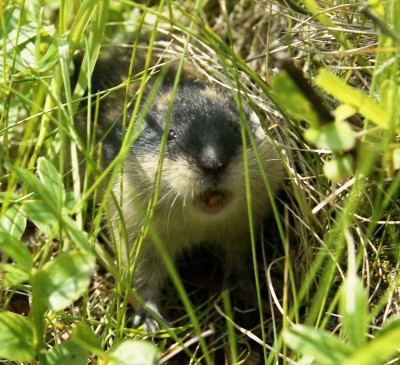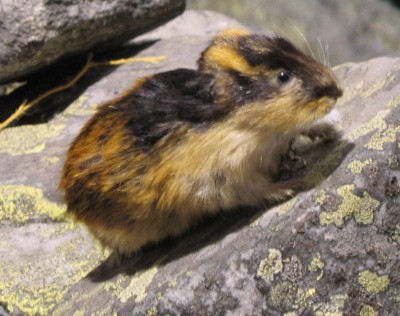Predictions that 2011 could be a ‘lemming year’ appear to have been correct, as the small, notoriously short-tempered rodents have begun popping up all over the mountainous areas of Norway, scaring skiers, swarming across roads and even attacking photographers.

Lemmings thrive during mild but snowy winters, as they build habitats under snow cover and can breed in great numbers. They can then burst forth during the spring and summer if key plants that the animals eat are given a warm enough spring in which to grow.
The recent warm April weather will have helped the lemmings further, after the mild winter led to predictions of a coming population boom. As the snow melts, lemmings migrate to higher ground, following the continuing snow cover. Lemmings are most common in northern Norway, and have all but disappeared in some parts of the south.
Potentially historic boom
Rold Anker Ims of the University of Tromsø told newspaper VG that Norwegians would have to look back to the 1960s for the biggest explosions of lemming populations, when people “had to scrape the roads for lemming corpses.” Ims was uncertain as to whether this year would reach such historic levels. Other areas, such as Hardangervidda in west Norway, have not seen a big “lemming year” since at least 1994. Nina E. Eide of the Norwegian Institute for Nature Research (NINA) confirmed to newspaper Aftenposten that she had received “many reports from people that have seen lots of lemmings,” which suggested that this year will indeed see a major population boom.
There are some researchers that still doubt whether it will be anything more than a normal population boom within the usual three to four year cycle. NINA’s Erik Framstad, speaking to VG, pointed out that “last year was registered as a lemming year” in a number of places, and that “it is seldom that there are two peaks after each other in the same place.”
‘Scrapped off skis’
Nonetheless, members of the public are already reporting a growth in the lemming population. At Skarverenn, one of the world’s largest ski races, a participant had to scrape a dead lemming off his ski at the end of the race, having seen many other lemmings alone the trail. Jan Karlsen, who was taking part in the race for the 26th time, had never caught one of the creatures in his skis.
Other skiers have also encountered the creatures. Aftenposten reported on the Steinvik family, who saw a large number of lemmings while on a skiing trip near Trondheim. One lemming became stuck to the ski of the father of the family, but the rodent, who became extremely angry, was able to get free without being hurt.
One Norwegian on holiday in Sweden was filming a lemming when it suddenly tried to jump and attack the camera. Rune Breen Nilsen described to VG how the lemming “became very, very angry” about being filmed, before jumping up towards the camera.
A mountain warden in south-east Norway, Magnar Nordsveen, told Norwegian Broadcasting (NRK) that he had not seen so many of the rodents since the end of 1970s. “I heard about someone that drove fro Tolga towards Sømådalen in Engerdal [south-east Norway], and counted over 300 dead lemmings on the way,” Nordsveen said. “This is because they cross the road and do not care about oncoming cars.” He added that they had come past his terrace “in waves” moving “enormously quickly.” Nordsveen also warned that many die in sources of water, and that people must be careful not to drink this.
Myths prevelant
There are many myths about lemmings. One urban legend that is popular in Norway is that lemmings can explode when they become very, very angry. Although this is not strictly true, researcher Per Gustav Thingstad of the Norwegian University of Science and Technology confirmed to NRK that lemmings can become so worked up that they develop metabolic and blood pressure-related problems that cause them to die of stress.

More commonly outside of Norway, many people also believe that lemmings commit mass suicides, often by accident, during long migrations. This myth is believed to have been propagated in particular by Disney, whose 1958 Oscar-winning documentary White Wilderness staged the jumping of a large number of lemmings over a cliff; it was further developed as part of an early, legendary computer game franchise called Lemmings, now one of the most popular computer game franchises of all time, in which players must build and clear obstacles in order to avoid the creatures running blindly into committing acts of mass suicide.
Good news for predators and grouse
The lemming explosion is good news for grouse, at least in the short term, who tend to be left alone by predators and birds of prey when a plentiful supply of lemmings is available. In the long term, it will mean that there are more grouse to be hunted in autumn. Grouse hunting returns have decreased in recent years. Although Statskog’s Jo Inge Breisjøberget warned that the relationship between lemming and grouse populations was “not as simple as people think,” she confirmed to Aftenposten that the prospects for grouse hunters looked good.
The greater number of lemmings is also good news for the artic fox, the snowy owl and many other predators, according to researchers quoted in Aftenposten.
Risk of disease
Lemmings can also carry a risk of disease, particularly tulameria (also known as “rabbit fever”), which often manifests itself in sore throats and large sores on the skin. 45 cases have been recorded so far this year in the Midt-Norge region alone, with the outbreak the biggest since the 1980s.
Chief medical officer Wik Larssen warned Norwegians in Aftenposten that they should not “pet or cuddle” lemmings. “Those that manage to pet them are usually also those that become sick,” Larssen advised. The doctor suggested that the number of cases was connected to the “lemming year,” particularly in terms of the animals infecting water supplies.
Views and News from Norway/Aled-Dilwyn Fisher
Join our Readers’ Forum.

